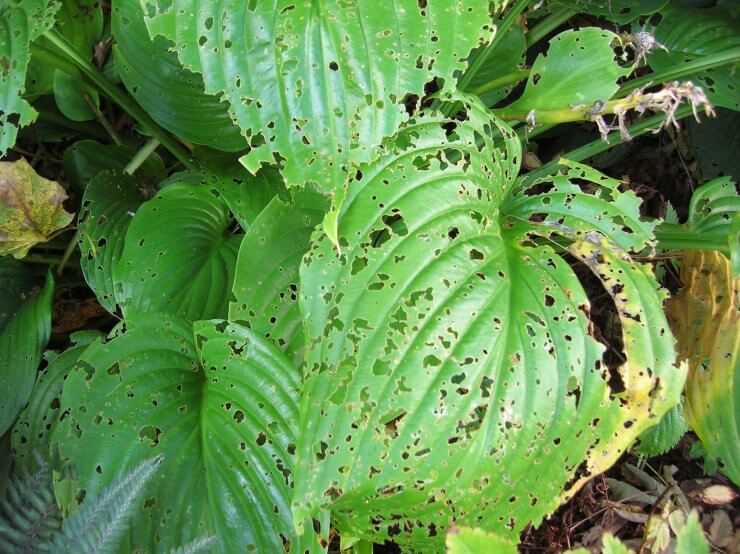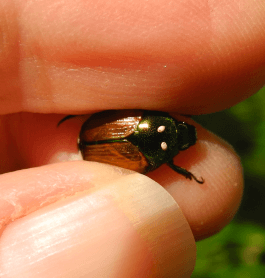
By the time fall rolls around, the hostas and the roses, the kale and beets and tomatoes all show substantial insect/pest damage. They aren’t the only things in the garden that have been under attack. All summer long the slugs, beetles, aphids and other creeping crawling things have been at work. And it shows. It isn’t pretty.
Yeah, I’ve flicked my share of slugs and snails off of plants (granted they are not insects per se, but like many insects, they do provide food for wildlife), squashed a few beetles, blasted away at aphids with a garden hose and hand picked other munching insects too. But I have not been the only one going after those pests. I’ve had help, lots of help in my critter skirmishes.
Birds and toads, tiny frogs too and even beneficial parasitic insects have found refuge and food in my gardens. Day and night they are patrolling the ground under the thick mats of foliage and from above in search of food. And their presence in the garden has added a lively and colorful welcome element of life. Song sparrows, cardinals, catbirds, robins and others have nested in the climbing roses and cedar hedge and trees overhead, finding meals and homes for themselves and their offspring. First attracted by the flowering plants, hummingbirds buzz by on their arial patrols for mosquitos to feed their hungry young. How can you put a value on that?
It’s a war out there. I’d wager neither of us — not I nor my wild friends — have won that war. Nor do I ever expect or hope we will. But we have managed to equalize the invasions. And that’s the crux of this issue. You see, I am actually welcoming those insect (and slug) pests into my gardens because I see them as an integral part of my environment. You could say they represent more of a balance than a pristine intact garden does. And in the meantime I am satisfied, yes even proud living with the evidence of those parts of my attempt at an equilibrium.
The alarming fact is that home gardeners use a lot of chemicals — pesticides, herbicides, fungicides — a plethora of “cides” to protect their flowers or food crops from insect damage, Actually they employ a great deal more than does commercial agriculture. That some of those chemicals are considered “organic,” does not erase the fact that they are used to kill. There are tiny, beneficial parasitic insects that often move in to feast on growing populations of insect pests. It’s just one example of how we can allow that complex world of insects to balance itself out. When we apply broad spectrum pesticides, we kill them all, the good and the bad. We home gardeners may not be the prime suspects in recent chilling reports of dramatic declines in insect numbers, but we have a long way to go to correct our part in those numbers.
A decade ago we heard the sobering news that honeybee hives were “collapsing” in droves. Disease and parasites were claiming untold numbers of honeybees. The calls for “save the honeybees” alerted many of us to do our part to help turn that trend around. We eschewed bedding plants that had been treated with systemic neonicotinoids that were reported to essentially render the plants themselves poison, even to pollinators. It was a wakeup call.
Next came the calls to “save the dandelions!” because they presented an early pollen source for honeybees. But here’s where things get a bit complicated. First off: Honeybees are not native pollinators, and dandelions are not native wildflowers. Honeybees were imported from Europe to pollinate a range of food crops — most of those which had been imported from elsewhere as well. That’s right, nearly every food crop — vegetable and fruit — grown here is not native. Give that a moment to sink in.
So we’ve got an entire food system here dependent upon an “alien” insect because that food system itself is composed of alien species. Ho boy. But wait! What about our native bees, insects and pollinators, you might ask. Where do they fit in? Where indeed.

Look closely at the image above and you’ll see two small opaque white dots on the shoulders of this invasive Japanese beetle. I could spray it with poison or dunk it in a jar of soapy water and be done with it. But I won’t. Those are the eggs of a tiny parasitic fly that will hatch out and devour this beetle from the inside-out. And those flies will then go on to vanquish even more pests. So I will let it go to finish the process and work for me.
Turns out some of them are the same insects gardeners have been poisoning for generations because some of them attacked our crops. And those native insects are the ones that are declining in ever-increasing numbers. And along with the decline in insect populations we have witnessed an equally alarming decline in birds. No bugs, no birds. So, you can begin to see how all of this is intertwined.
Although those alien food crops, and ornamentals too, have presented grand feasts for honeybees, they don’t offer much for our native pollinators. Our local pollinators prefer plants that are native to this continent. They have evolved to rely upon the nutrients that native plants provide for them. Turns out those dandelions that we’ve been urged to let take over the lawn, are not really that nutritious for our native pollinators. Better to add clover to the lawn or allow some early flowering natives and join the “no mow May” group to allow those solitary, native ground-nesting bees an opportunity to hatch and feed. And entomologists have found that honeybees are out-competing our local pollinators for pollen sources in general. See where this is going?
Without diving into a detailed study of entomology (the science of insects), suffice to say there are good reasons why we are encouraged today to plant native species of trees, shrubs and flowers —to help support our native insects. Don’t get me wrong, I am not suggesting you rip out every non-native element of your landscape and replace it with a field of wildflowers. Though that would be good.
But we have to be realistic, and realize there are limits to what we can accomplish. Planting that wildflower field means a lot more than spreading a handful of seeds. Most native plants are very site specific. They are not always easy to establish, especially in a landscape that is not their usual range, and even when it is because it has been disturbed over time and does not necessarily offer the unique conditions for various natives to thrive. Case in point — observe any vacant lot that has gone to weeds, and you’ll probably see one dominant species taking over, crowding out everything else. It does not automatically revert to native habitat.
So what’s a concerned gardener to do? I don’t have all the answers, but there are some simple things any of us can do for a start. Once you set yourself on the path of embracing those insects and those visiting animals and other insects that utilize them, you will see a balance begin to evolve. Here’s a list:
- Avoid chemicals in the garden, even so-called “organic” ones
- Use compost, organic soil amendments like fish or kelp concentrates for healthy plants that resist insect and diseases
- Inspect plants daily to ward off destructive insect invasions
- Encourage birds and other insect predators, even wasps with a water source, native bee nesting boxes
- Plant natives when possible
- Leave those fall leaves to provide cover and nesting for native insects
- Skip the extensive fall cleanup of perennials with seed heads for winter food for birds and cover for native bees and insects
- Join the “no mow May” group and let the lawn go
By the very act of creating a garden we disturb, disrupt what we have come to know as “nature,” no matter how naturalistic our landscape design is or what it contains. So as gardeners, we have an obligation to protect our environment in every way we are able. Give it a try and give it time. And there’s something else you might notice about this approach — it can save time, effort and money while enriching our lives and our environment too.
So the next time you notice those “lace-leaf” hostas or slightly-chewed cabbage leaves, you can give yourself a pat on the back as you embrace that insect invasion. It is a sign you care and are doing something good for your environment.
Lynette L. Walther is a member of Garden.Comm. She is the recipient of the Garden.Comm Gold Medal of Achievement, five time recipient of the Silver Medal of Achievement for writing and she is the author of “Florida Gardening on the Go.”




this was quite eye opening, but frustrating as well. There is so much to learn…what is native? what is beneficial? how do we preserve what is food? thank you for the article.
Indeed it is a lot to take in, given how we have always been told we could “spray away” whatever insect we did not like. If gardening is anything, it is a process of learning what really works and what does not. Thankfully today we are armed with a lot of knowledge of how we impact our environment — both positively and negatively.
Excellent post Lynette on the importance of planting native wildflowers. Thx